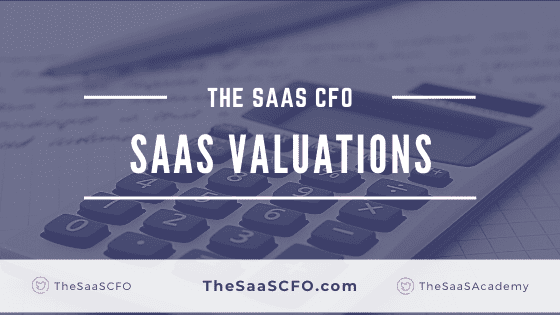SaaS valuations can be a tricky subject for founders. There’s a ton of info on the Internet, especially for public SaaS companies. Unfortunately, for private SaaS companies, there is only random valuation data and rules of thumb. There are no hard and fast rules that pinpoint the value of your private SaaS company.
To help shed some light on SaaS valuations, I interviewed Karam El-Harami, a senior associate with Software Equity Group (SEG). SEG is a boutique, sell-side M&A firm that is based in San Diego, CA. It works with B2B SaaS companies that are looking for a majority recap or to exit.
I paraphrased our conversation below to highlight the major tips and guidance when it comes to private company SaaS valuations. You can also find the full interview at my The SaaS CFO podcast.
Is there a myth that strategic buyers will pay more than financial buyers?
Karam: It is not a myth. Typically, strategics will pay a higher multiple than private equity firms simply because of synergies and differentiation. That being said, I would say recently, most recently, we started to see private equity firms become more competitive than they’ve ever been.
Really, it’s because their mandate is to spend their dry powder on the companies that obviously they see an opportunity to grow and scale. With companies that check all their boxes that are a scarce asset in an attractive market, ones that they can build an M&A and organic growth thesis around it, they can get competitive, but no, I don’t think it’s a myth.
Strategics will pay a higher multiple than private equity firms simply because of synergies and differentiations.
Karam El-Harami, SEG
When does it make sense to use a multiple of ARR or EBITDA to drive SaaS valuation?
Karam: No company is exactly the same as the other, but generally speaking, it really depends on where the company is in its maturity lifecycle. In the earlier stages, companies are typically focused on growth and reinvestment into the business, so they’re not really focused on EBITDA and profitability. They’re just trying to grow the top line. Focusing on ARR and ARR multiples makes a lot of sense versus when a company is much larger.
Further along in their maturity lifecycle, growth will still be there obviously, but it will slow down just given the scale of the business. Generally, companies are starting to generate cash. There’s more profitable now than they were maybe five or six years prior. Maybe in that scenario, it would make more sense to look at profitability or EBITDA versus ARR, but it really depends on the company profile and where they are in their maturity lifecycle.
Ben: It sounds like early growth, early stage, you’re growing hyper-fast, you’re reinvesting profits, so maybe a multiple of ARR makes sense. But as you scale, now you’re acquiring companies and you’re growing nicely, but then you have to reach profitability at some point, and then maybe EBITDA makes sense.

How does total addressable market (TAM) fit into the valuation story? Can it increase or decrease valuation multiples?
Karam: I wish it was black and white, where the company is in the lifecycle. It’s obviously more than that. If a company is earlier on, they’re growing like crazy, but they’re playing in a very small market, their total addressable market is pretty small, that will cause even if you’re still looking at an ARR multiple, a slight dip or somewhat of a discount because you can continue growing that at that rate, but for how long are you going to tap out your market?
You’re going to start thinking of maybe different products or expanding into other markets to sustain that growth. At the surface, growth rate is phenomenal and focusing on growth is great, but looking also more macro, what’s my total addressable market? That also plays a huge factor in terms of evaluating a company.
Ben: So really interesting where the TAM overlay on multiples can either boost it a bit or decrease those multiples.
Total addressable market can either boost valuation mutliples or have a draft effect.
Ben Murray
Is valuation a chicken or the egg concept? Aren’t multiples really the result of due diligence and financial analysis?
Karam: I 100% agree. It’s the end result. Obviously, the biggest driver of multiples are metrics of the business, looking at growth rates, looking at retention, diving deeper into gross profit, looking at unit economics for the business, segmenting it on a customer basis or per product depending on the offering.
Just looking at those dynamics, that really all comes together to give you a valuation for the business. And then additionally, then you start looking at a macro level like I mentioned, total addressable market, look at differentiation.
How important is product differentiation?
One of the most important things is product differentiation. We’re living in a world where there are tools in whatever market you’re looking at. How do I differentiate? Why is my business worth X versus somebody else’s? If all else is equal, it’s differentiation, for example. It starts with the metrics. That’s definitely the heart of it, but there’s obviously more to it as well.
How is important is the documentation around IP ownership?
Karam: That’s an important one. IP ownership is very critical for buyers. Obviously, when you’re selling your business, the buyer needs to know are you selling something you own because if you don’t, then it’s risky, and with risk comes lower multiples. Nobody wants to take on risk. IP ownership is very critical as well.
With risk comes lower [valuation] multiples.
Karam El-Harami, SEG
How do investors view founders building their product on a third-party platform?
Karam: They will do more due diligence. Most likely, what we’ve seen typically is that it would result in some sort of a discount just because it just begs the question of dependency. If it goes away, is your development relying on somebody else’s resources? It does raise the question of additional due diligence and risk. Typically, like I mentioned, risk, unfortunately, comes with some sort of discount.

What SaaS metrics should founders and finance teams be aware of that are correlated to driving valuation?
Karam: They are very important. Real quick circling back on my comment about earlier the myth, it’s not a myth. PEs will get competitive if a company checks all their boxes. Some of those boxes are metrics, are growth rates, are retention metrics, both gross and net retention. There are unit economics in a sense diving into the sales aspect of it.
All those metrics are very important to track, especially if you’re able to track it on a per segment, whether it’s a customer segment, whether it’s a module, a product, whatever it might apply for that business. Obviously, every business is different.
Tracking those is very important because those are the questions buyers are going to ask; PEs are going to ask for. That’s how, even before you get to a multiple, if growth doesn’t exist, if retention isn’t that good, you’re not even going to get that far along with most private equity firms to even have a conversation because growth and retention are very critical when it comes to the buyers’ eye.
Founders, you have to know your numbers, your SaaS metrics. Do you understand your financial profile?
Ben Murray
Is gross profit important in SaaS valuations?
Karam: I would say gross profit margin is very important, especially in our world of software. Tracking it both overall and just simply recurring margin off of the recurring revenue is very, very important. That’s something that should be tracked.
What’s also important for some private equity firms or some buyers, but not all, I would say is EBITDA. That’s where you get in the details of what their investment criteria is. For some break even or close to break even is fine. For some, it’s a minimum of X dollars of EBITDA.
What do SaaS founders need to think about to get their house in order? If they’re thinking about an exit process?
Karam: I would say implementing systems that track those metrics that we just talked about, working with a third party, maybe accounting firms or other third parties that are helping them clean that data for historical periods and helping them implement these systems going forward because historical trends are very important when evaluating any business.
Having access to all that clean and reliable data is very important. I would say working with a legal team to focus on cleaning up all the legal documents. Typically, legal due diligence is approached at the very end which can be a tedious process. What you don’t want to do or you’d like to avoid is at the 11th hour having to clean documents or collect signatures or whatever it may be. Having all that done in parallel would be very helpful. And then most importantly though, I would say focusing on not only growing the business but product differentiation. That’s very important as well.
When does it make sense for a founder or founding team to run what I call a formal exit process?
Karam: I would say always. A formal exit process can be you could be engaged with a third party, with an M&A advisor, a banker, and you could run a broad process and you could run a process where you’re talking to a limited number of buyers and PE investors, or you could run a formal process with just one party. I would say all of these fall under the umbrella of a formal process, obviously, because you’re engaging a third party.
The reason why I say always because whether you’re talking to one party or you’re talking to 150 parties, you’re going to have to clean up that MRR data, you’re going to have to look at retention, you’re going to have to slice and dice the analysis and the data, you’re going to have to highlight the strengths of the business and position around the weaknesses of the business.

Are all revenue streams made the same in the world of valuation? Is subscription revenue still king in the valuation world compared to usage, transaction, etc.?
Karam: You’re absolutely right. You’re starting to see a lot more usage of transactional revenue streams than you probably did five to 10 years ago. That being said, contracted subscription revenue is still king. It ties back to what we’re talking about, about risk. When a customer is contracted for a year or however many months or years and for X dollars, that’s less risky because they’re contracted.
Versus if it’s variable based on usage or transactional, there’s a lot more risk, and that really showed last year when COVID hit. You saw businesses’ revenues just decline. If you look at Eventbrite’s enterprise to revenue value, it went from double digits to single overnight. That’s purely because there’s no contracted revenue. There were no events going on; there was no ticketing there. It just didn’t make sense.
Contracted subscription revenue is still king.
Karam El-Harami, SEG
That being said though, what we’re starting to see and what we like to see with some of the businesses we work with is that they’ll have a base subscription that’s contracted, but then they’ll have also an additional usage or transactional revenue stream. It could be as simple as payments where they get a percentage of the payments that go through the system or usage base or users or whatever it may be.
That’s nice because you kind of de-risk because you have your subscription which would still be the bulk of the recurring revenue, but you have that reoccurring that gives you an upsell that is very nice and obviously helps drive net retention. We like to do that. We like to see that. And then, like I said, it’ll be less risky than just simply having a transactional revenue stream because nobody expected a global pandemic, and it happened overnight and you saw what happened. It’s nice to have that contracted revenue stream.
Are you seeing more payment processing revenue streams? Are companies taking a percent of payment?
Karam: Yes, it’s more common now than it ever was. And then, we are starting to see more companies start to think that way where they’re like, “Wait. We’ve been doing this. Might as well monetize off of it.” That’s an opportunity that can be seen as a low-hanging fruit opportunity for a lot of businesses.
That’s attractive, especially for private equity firms if they’re able to know with little work and just generate more dollars, even if it’s transactional in this case, it’s a small percentage. Why not? The pro of it definitely outweighs the con.
That’s a Wrap!
I hope you enjoyed this interview. It was packed with great insight into the SaaS valuation process. I would love to read your comments below regarding how you approach SaaS valuations.
I have worked in finance and accounting for 25+ years. I’ve been a SaaS CFO for 8+ years and began my career in the FP&A function. I hold an active Tennessee CPA license and earned my undergraduate degree from the University of Colorado at Boulder and MBA from the University of Iowa. I offer coaching, fractional CFO services, and SaaS finance courses.
